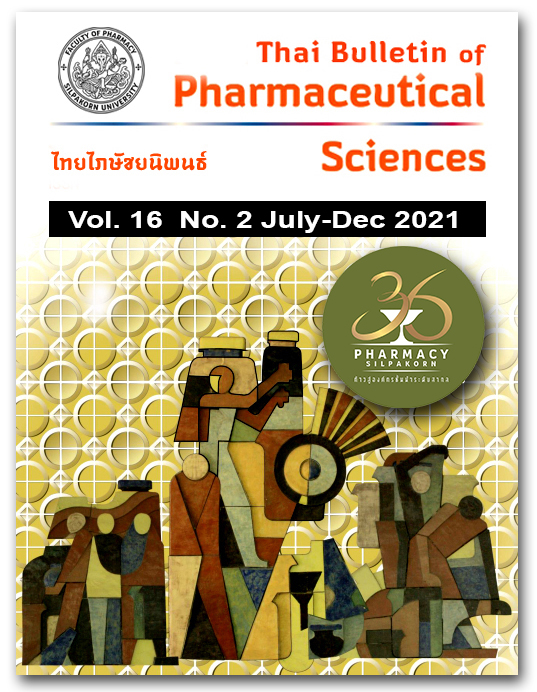PINOCEMBRIN ATTENUATES COLISTIN-INDUCED HUMAN RENAL PROXIMAL TUBULAR CELL APOPTOSIS
DOI:
https://doi.org/10.69598/tbps.16.2.1-9คำสำคัญ:
Colistin, pinocembrin, renal proximal tubular cells, mitochondrial dysfunctionบทคัดย่อ
Colistin is an essential last-resort polypeptide antibiotic widely used for treatment of multidrug-resistant (MDR) caused by the emergence of gram-negative bacterial infection. However, the adverse effect of colistin has been associated with nephrotoxicity. The nephrotoxicity is mediated by excessive production of reactive oxygen species (ROS) and mitochondria damage in renal cells. Pinocembrin, one of the dominant bioactive compounds extracted from Boesenbergia rotunda, presents antioxidative properties and preventive role against mitochondrial dysfunction. Thus, this study aimed to investigate the renoprotective effects and cellular mechanisms of pinocembrin against colistin-induced renal proximal tubular cells toxicity. The results revealed that colistin treatment significantly reduced cell viability and enhanced apoptosis of human renal proximal tubular cells, RPTEC/TERT1 cells, compared with vehicle. These effects were attenuated when co-treated with pinocembrin. Moreover, colistin-activated cytotoxicity including ROS generation, loss of membrane potential and upregulation of apoptotic proteins expression such as cytochrome C and caspase-3 were suppressed in pinocembrin treatment. Therefore, pinocembrin exerts protective effects against human renal proximal tubular cells apoptosis by ameliorated colistin-induced mitochondrial impairment.
เอกสารอ้างอิง
Zager R, Gamelin L. Pathogenetic mechanisms in experimental hemoglobinuric acute renal failure. Am J Physiol Renal Physiol. 1989;256(3):446-55.
Choudhury D, Ahmed Z. Drug-associated renal dysfunction and injury. Nat Clin Pract Nephrol. 2006;2:80-91.
Bialvaei A, Samadi Kafil H. Colistin, mechanisms and prevalence of resistance. Curr Med Res Opin. 2015;31:707-21.
Mohamed Y, Abou-Shleib H, Khalil A, El-Guink N, El-Nakeeb M. Membrane permeabilization of colistin toward pan-drug resistant Gram-negative isolates. Braz. J. Microbiol. 2016;47(2): 381-8.
Gai Z, Samodelov S, Kullak-Ublick G, Visentin M. Molecular mechanisms of colistin-induced nephrotoxicity. Molecules. 2019;24:653.
Lee T, Bae E, Kim J, Jang H, Cho H, Chang S, et al. The aqueous extract of aged black garlic ameliorates colistin-induced acute kidney injury in rats. Ren Fail. 2019;41:24-33.
Nilsson A, Goodwin R, Swales J, Gallagher R, Shankaran H, Sathe A, et al. Investigating nephrotoxicity of polymyxin derivatives by mapping renal distribution using mass spectrometry imaging. Chem Res Toxicol. 2015;28:1823-30.
Ghlissi Z, Hakim A, Mnif H, Ayadi F, Zeghal K, Rebai T, et al. Evaluation of colistin nephrotoxicity administered at different doses in the rat model. Ren Fail. 2013;35:1130-5.
Dai C, Li J, Tang S, Li J, Xiao X. Colistin-induced nephrotoxicity in mice involves the mitochondrial, death receptor, and endoplasmic reticulum pathways. Antimicrob Agents Chemother. 2014;58(7):4075-85.
Jing LJ, Mohamed M, Rahmat A, Baker MFA. Phytochemicals, antioxidant properties and anticancer investigations of the different parts of several gingers species (Boesenbergia rotunda, Boesenbergia pulchella var. attenuata and Boesenbergia armeniaca). J. Med. Plants Res. 2010;4(1):27-32.
Sohn JH, Han KL, Lee SH, Hwang JK. Protective effects of panduratin A against oxidative damage of tert-butylhydroperoxide in human HepG2 Cells. Biol. Pharm. Bull. 2005;28(6):1083-6.
Gu X, Zhang Q, Du Q, Shen H, Zhu Z. Pinocembrin attenuates allergic airway inflammation via inhibition of NF-κB pathway in mice. Int Immunopharmacol. 2017;53:90-5.
Lee E, Kim S, Choi M, Yang H, Park S, Oh H, et al. Gene networking in colistin-induced nephrotoxicity reveals an adverse outcome pathway triggered by proteotoxic stress. Int J Mol Med. 2019;43: 343-55.
Kowaltowski A, Castilho R, Vercesi A. Opening of the mitochondrial permeability transition pore by uncoupling or inorganic phosphate in the presence of Ca2+ is dependent on mitochondrial-generated reactive oxygen species. FEBS Lett. 1996;378:150-2.
Gottlieb E, Armour S, Harris M, Thompson C. Mitochondrial membrane potential regulates matrix configuration and cytochrome C release during apoptosis. Cell Death Differ. 2003;10:709-17.
Das K, Roychoudhury A. Reactive oxygen species (ROS) and response of antioxidants as ROS-scavengers during environmental stress in plants. Front. Environ. Sci. 2014;2:article no.53.



